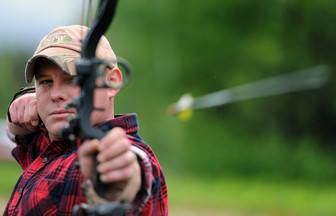Posted by Archery Country on Oct 18th 2019
What is IBO speed?
Archery and bow hunting have a lot of different terms and acronyms which can be confusing for the new bow enthusiast. If you're new to archery and looking at bows, chances are you've seen something called IBO speed marked on the bows you've been considering. IBO and ABO are standards when it comes to bow speed, and as each number is arrived at differently, it's important to understand what they mean.
What is IBO?
IBO stands for the International Bowhunters Organization. The International Bowhunters Organization has created a standard for bows which is produced through a test. The IBO speed is obtained by shooting a bow with the maximum pull weight of 80 pounds +/- 2 pounds. The arrow used will be 400 grains or 5 grains per pound of draw weight. No required draw length. The measurement is taken at the bow's point blank range. So technically, the high the IBO number, the more powerful the bow.
This being said, the IBO tests can be somewhat lax with manufacturers using bow weights up to 82 pounds and draw lengths at almost 33 inches. So, if you compare two bows with close IBO numbers, you have to remember that one number may be strictly 80 pound draw weight and 30 inches draw length and the other may not be.
Another Standard of Measurement: ATA
IBO isn't the only standard for bows. The Archery Trade Association or ATA offers a bow standard as well. The ATA speed is obtained by shooting a bow with the maximum pull weight of 70 pounds +/- .2 lbs. The arrow used will be 350 grains or 5 grains per pound of draw weight. They set the draw length at 30 inches + 1/4 inch. ATA is considered a more precise number to compare when considering buying a bow. You may find that some bows have both IPO and ATA standards listed.
That being said, many companies do not list the Archery Trade Association standards on their bows. Those that do will either list ATA or IBO/ATA numbers, which may or may not be helpful to have both IBO/ATA numbers present.
Is IBO the Best Metric for Buying a Bow?
At this point, you may be wondering if the IBO number is the best metric to use when buying your bow. There's a lot of wiggle room and fudge factors when it comes these numbers, and in fact, you may have two bows which have different numbers, but one the one bow with a lower IBO number could be faster than the bow with a higher IBO number. This is why you shouldn't choose a bow just on the IBO number and instead on the features it has. If it has an ATA number, you can expect a bit more consistency, but understand that ATA doesn't enforce its standards, which means companies can declare whatever they want to. Also to make matters more complex, many archery companies only use IBO standards and not ATA standards. And then, there are the companies who do not list bow speeds. Which means, it's anyone's guess what the bow speed is unless you test it out with a chronograph or do some fancy calculations on arrow speed, you're unlikely to have a number you can hang your hat on.
So, what does that mean for the bow you're thinking about buying? Sure, the speed is important for penetration, but there are other important factors to consider. You will want to consider your bow's quietness, pull, construction, quality, and draw smoothness. You also want to be able to test out the bow by shooting it. Trying out bows is important because you won't know how the bow shoots until you do. Like anything, the bow speed is just one factor of the entire package.
Now, when your buddies brag about their IBO number, you can set them straight how imperfect the measurement is because you know the truth.

